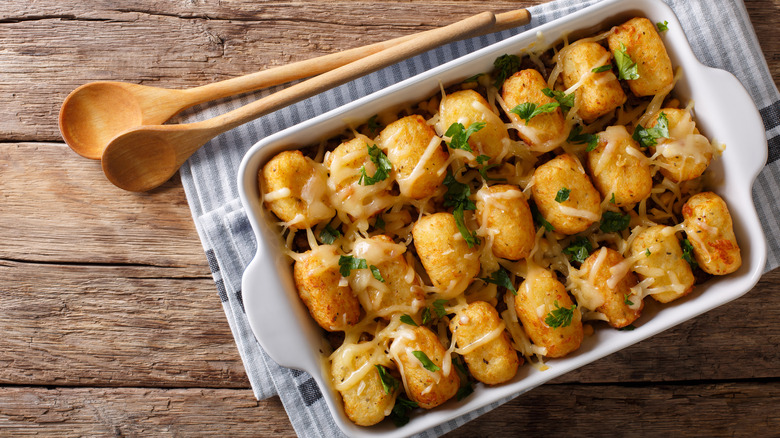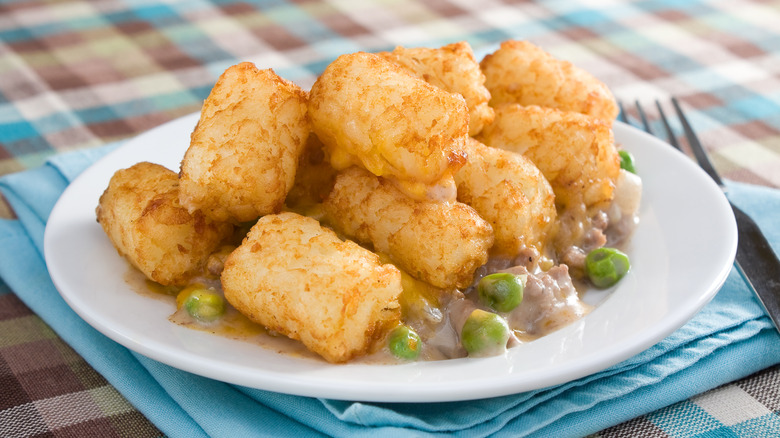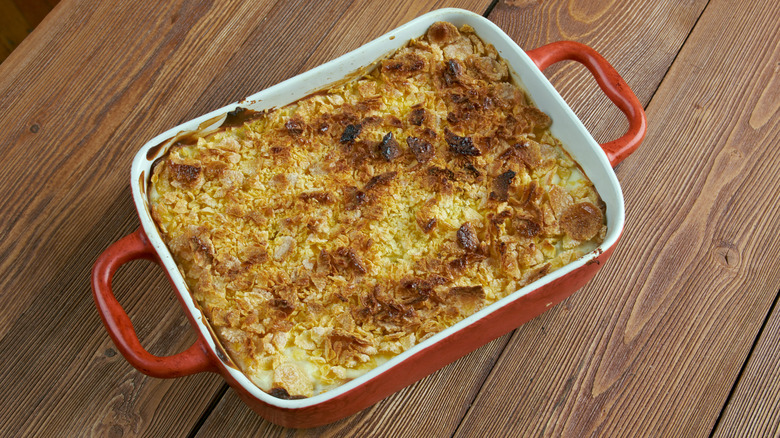What Exactly Is Minnesota Hotdish, And Is It Different Than A Casserole?
If you hail from a certain part of the Upper Midwest (namely Minnesota and North Dakota), you probably grew up eating hotdish. It practically runs in people's bloodstreams there, a staple main course at potlucks, church suppers, and family get-togethers. But describing hotdish to an outsider is no easy feat. It doesn't have a strict definition, and that's kind of the point. It's a meal of necessity, made with whatever you have on hand at the time. The name is easy to explain — it's a hot meal prepared entirely in a casserole dish — but exactly what goes into that dish can vary significantly. The basic elements are meat, vegetables, starch, sauce, and toppings, but the specifics are up to each cook.
The meat is typically ground beef, though you could use chicken, turkey, pork, or even tuna. The vegetables are usually canned or frozen. The starch could be macaroni noodles or rice, particularly wild rice, which is native to Minnesota. The sauce is made from canned condensed soup, the most popular varieties being cream of mushroom and cream of tomato. The most recognizable topping is a layer of Tater Tots, which may stand in for the starch as well, although fried onions, potato chips, chow mein noodle crisps, and good old melted cheese are also popular choices. At this point, those of you unfamiliar with hotdish might be thinking, "Hang on, that's just a casserole." You're not wrong, but you're not quite right either.
A hotdish history
To really understand hotdish, you need to know how it came to be. Hotdish was popularized during the Great Depression as a way to stretch a small amount of meat into a meal for the whole family. The use of canned goods added volume to the dish while keeping the budget within reason. The word "hotdish" first appeared in print in a 1930 community cookbook published by the Grace Lutheran Ladies Aid in Mankato, Minnesota. The recipe, written by Mrs. C.W. Anderson, called for ground beef, canned tomato soup, peas, celery, and macaroni noodles (specifically Creamette macaroni, made in Minneapolis). However, the circumstances of the Depression meant that recipes couldn't always be followed to a T. You had to make do with whatever you could get, and thus hotdish came to have a very flexible definition.
Today, the most defining feature of hotdish is not any of the ingredients it contains, but rather the nostalgia it evokes. It's widely considered to be the culinary calling card of Minnesota and an integral part of the state's cultural identity. To celebrate this fact, and to spread the good word of hotdish to other corners of the nation, Minnesota's Congressional Delegation has held an annual hotdish competition since 2010. Each of the two senators and eight representatives prepares their own take on hotdish to pit against each other. The record for most wins currently belongs to Tim Walz. The now-governor racked up three victories during his time in the senate.
Hotdish versus casserole
Now we come to the most question: what makes hotdish different from a casserole? It's hard to answer, because neither of them are well-defined. We've already discussed the loose parameters of hotdish, but casserole is an even looser concept. There are countless casserole recipes, and the only thing they all have in common is the dish they are baked in. In fact, the word "casserole" comes from the French "cassole," which roughly translates to "saucepan." Outside of the cookware itself, casserole has no firm definition. In this sense, you could say that lasagna is a casserole (although you probably shouldn't say that unless you want to start a war with Italy).
All that being said, hotdish has a slightly narrower definition than casserole. For example, a green bean casserole, devoid of the meat and starch components, is not a hotdish. Therefore, it can be said that hotdish is more or less a subcategory of casserole. All hotdishes are casseroles, but not all casseroles are hotdishes. But the main difference between hotdish and other casseroles is where you make it. What someone in Minnesota or North Dakota would call hotdish, a person in Indiana would simply know as tater tot casserole. It's not really about the ingredients, or even the dish you bake them in. Hotdish is a sense of place, a mood, a reflection of the past. It fills your stomach, sure, but it also fills your heart.


